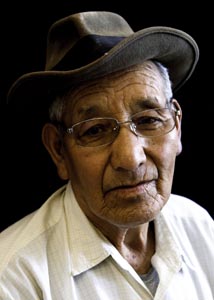Name: Kalsang Dakpa
(Alias: No)
Gender: Male
Interview Age: 78
Date of Birth: 1934
Birthplace: Namay - Porang, Utsang, Tibet
Year Left Tibet: 1959
Profession: Farming
Monk/Nun: Previously
Political Prisoner: No

Interview No.: 11D
Date: 2012-05-16
Language: Tibetan
Location: Mcleod Ganj, Dharamsala, Himachal Pradesh, India
Categories: Buddhist Traditions
Keywords: childhood memories, Chinese -- oppression under, clothing/weaving, escape experiences, monastic life, pilgrimage, refugee in India -- life as, thamzing/struggle sessions, Utsang
Summary:
Kalsang Dakpa was born in Namay village, which he describes as the birthplace of Chogyal Norsang, a religious king of Tibet. Kalsang Dakpa's father was a boot maker and a tailor. He describes the different types of boots and dresses that his father stitched. He became a monk at the age of 3, but continued to live at home for a few more years. Once he moved to the monastery he was assigned duties as a conch blower and kitchen worker.
Kalsang Dakpa talks about the various stages in a monk's life, such as taking the rabjung and gelong vows. He explains the daily meals, division of labor and studies at the monastery. He was not good at memorizing religious texts and was relegated to making tea offerings. Once he turned 20 he became a kitchen overseer. Kalsang Dakpa ran away from the monastery to join his brother on a pilgrimage. He talks about his journey to Bodh Gaya in India and Lhasa soon after the Chinese invasion of Tibet.
Kalsang Dakpa recounts that the Chinese initially ordered monks in his monastery to subject their deceased leaders to thamzing 'struggle sessions.' Then they were told to falsely accuse and beat living people and Kalsang Dakpa did not like to be forced to do such acts. He was also discouraged because the Chinese had banned religious practice in the monastery. He and five other monks decided to escape to India in 1959.
Interview Team:
- Marcella Adamski (Interviewer)
- Tenzin Yangchen (Interpreter)
- Pema Tashi (Videographer)

